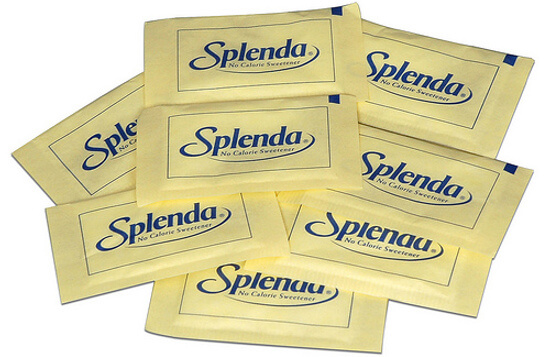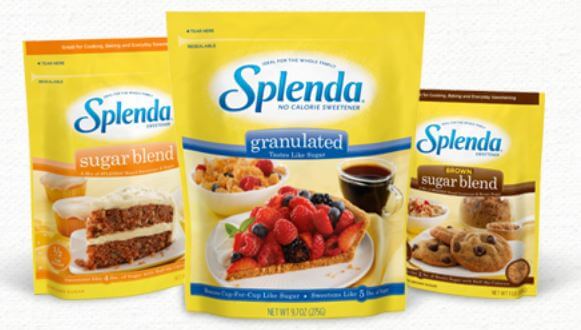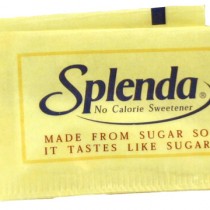Have you heard the controversy over Splenda? We’ll get to the bottom of it today.
When you’re hitting the gym hard and trying to work on your physique, fitness, and overall wellness, you don’t want all of your hard work going to waste. And nothing ruins that time at the gym quite like a candy bar or a soda. These temptations are everywhere – on TV, in the store, in your pantry, when you go out to eat. It’s really really hard to battle the never-ending fight against sugar, and this is really your worst enemy when it comes to controlling fat.
And when you’ve got a sweet tooth, sometimes you’ll do anything to satisfy it. We all have our food weaknesses. In fact, you might go into a sugar-crazed feeding frenzy every once in a while. We get it – we’ve all been there. But put down the candy bar and keep reading.
This could be why so many people have fallen in love with Splenda. It’s a great way to give yourself something sweet without ruining your hours spent at the gym. And because it has less calories and bad-for-you-stuff, a lot of people are turning to this artificial sweetener as their savour. But is it really better for you?
Splenda, Sucralose, and Sweetness
But what is Splenda? And what is Splenda made of?”
Let’s get right into the details and reviews of this artificial sweetener. There are a few new studies that show some seriously interesting findings.
A lot of people turn to Splenda as their sugar substitute. Whether they’re using it in their coffee or for baking, there are millions that use this product every day. So we decided to take a look atPrecision Nutrition reviews on the product.
Splenda is primarily made of sucralose. Because a lot of people don’t know much about sucralose, they tend to ask, is sucralose safe? Sucralose is a disaccharide, which actually means “two sugar,” and is made by replacing three hydroxyl groups with chlorine. Yes, this is the same chlorine used in swimming pools. While the FDA has not ruled sucralose itself unsafe, it is most definitely a highly processed artificial sweetener made using chlorine to obtain its intense sweetness. You can read more about that on a site called Truth About Splenda.
So it’s no wonder why Splenda’s slogan is “Made from sugar so it tastes like sugar.” There is actually sugar in it. But, because their customers were turning to Splenda as a replacement for sugar, they obviously got some backlash from it. They changed it to, “Starts with sugar, tastes like sugar, but is not sugar.”
Okay, got it. So it smells, tastes, looks and feels like sugar, but it isn’t sugar. So what the heck is it? We’re guessing people don’t know, because a recent survey by Johnson & Johnson (the parent company to Splenda) showed that 47% of participants didn’t know that Splenda wasn’t a natural product. Interesting…
Despite some of these questionable factors, there are some perks to sucralose.
Here’s the top three:
- There isn’t really an aftertaste (so no nasty, chalky gross taste lingering in your mouth)
- It’s able to be heated (so you can cook with it, add it to your coffee, do whatever else you want to do with heated sucralose)
- It’s secure in various acidities (aka if you mix it with lemon juice, it isn’t going to turn into a nasty glob of tasteless nothing)

Is Splenda Safe?
So to ask the question again, is sucralose safe? Well, the FDA approved use of this product back in 1998. They had a lot to say about it – but we’ll break it down and simplify it for you.
Let’s say a 150-pound (68.2 kg) person is wondering how much sucralose they should consume in a day. According to the FDA, it’s about 1.6 mg per kilogram of that person’s body weight. So for our little test subject, it would be 109 mg of sucralose daily.
According to the FDA, 5 mg/kg/bw/d is still considered a safe amount of sucralose to ingest.
What does this mean for our sweetness? Sucralose is 600 times sweeter than average sugar. 600! That’s a whole lot sweeter. Maybe that’s why people love it?
We’ll put some numbers out there so you can get the real picture. 109 mg of sucralose equals 65.4 grams of sugar (or 15.9 teaspoons). 321 mg of sucralose equals 204.6 grams of sugar (or 48.7 teaspoons).
But, because Splenda is only 1.10% sucralose, you don’t really have to worry about overdoing it on sucralose. In fact, in order to reach the FDA’s 5 mg/kg bw/d amount of sucralose, you’d have to consume about 454 mg/kg/d of it. That’s about 31 grams of Splenda. And that’s a lot, even for the sweet lover.
Here’s how Splenda Breaks Down
Whenever there’s a maximum dosage on a product, people tend to get a little nervous. After all, accidents happen. So before you start asking, “Is Splenda bad for you?” allow us to explain.
Back in 1976, Professor Leslie Hough was messing around in his lab, located in Queen’s College, London. He decided to ask a foreign grad student, Shashikant Phadnis, to give a compound a “test” in the lab. When Phadnis heard “test,” he thought he meant “taste.” So he tried it!
Luckily, they weren’t testing the effectiveness of poison that day. Instead, they were working on halogenated sugars that day. So Phadnis made a little discovery of his own. He tried a compound and uncovered its amazing sweetness. So the professor and the college avoided a whole lawsuit they would have gotten if he died. And instead, they made the most out of the could-have-been disastrous experience. They had discovered sucralose.
A lot of artificial sweeteners have actually come about this way. Constantin Fahlberg decided to pour a chemical he was working with on his sandwich – and boom, saccharin was born. And let’s not forget Jim Schlatter, who decided to taste his finger during work one day and discovered aspartame. Now, we aren’t saying go to your neighborhood lab and start licking stuff. Just giving you some cool background on how these components get discovered.

Splenda Research
Luckily, more curious (and slightly insane) scientists decided to look at how safe Splenda nutrition is. So they looked at our mammal friends, rats to examine the safety of Splenda in the rats’ gastrointestinal tracts.
So here’s what they did first. The first group of rats was all adult males. And for 12 weeks, they were given different concentrations of splenda. The dosages ranged from 100, 300, 500 and 1,000 mg/kg/day of splenda. This equals out to 1.1, 3.3,5.5, and 11 mg/kg/day of sucralose.
So, fecal matter was collected for 12 weeks (someone definitely didn’t get paid enough for that job) and pH and bacterial levels were measured. Also, each rat was weighed every single week.
After the 12 weeks were over, half of the rats had to be put down so their small and large intestine could be analyzed. The remaining rats were then given water for 12 weeks. Those were the lucky ones, I guess.
The most interesting thing scientists discovered? Even at the lowest dose of Splenda (which is the expected daily intake amount), the rats had a pretty large weight gain. However, the rats that were given the higher doses didn’t have a big weight gain. Why? Maybe the body felt like it had to compensate protein in order to deal with the high level of sucralose it was dealing with.
So, over the whole 24-week study, the rats given 100/mg/kg/day had a big weight gain. But the rats with 300 mg/kg/day didn’t. This is super strange, because you would expect them to either gain weight from the sucralose or plateau.
Also, after the first 12 weeks of consuming Splenda at all levels, the person with the lovely job of analyzing the rat poop saw that these animals had a lot less of the “good” bacteria in their tracts. Even more shocking – even after the 12 weeks of “recovery” with water, the damage was still done. Their numbers of good bacteria had barely gone back up.
How could this be? Well, p-glycoprotein (with the better, shorter nickname of p-gp), serves as a chemical transporter in the intestines. So when splenda is consumed at 300 mg/kg/day and 500mg/kd/day, the amount of p-gp increases. But here’s the confusing part – when it’s at 1000mg/kg/day, the results show a major decrease. What the heck?
When you have more p-gp in your body, you are able to transport more chemicals. So, sucralose is probably being transported – but what does that mean? At 300 mg/kg/day, your body is trying to get rid of sucralose. But when it gets up to 1000mg/kg/day, something else takes over. What is it? Cytochrome P450. Another protein.
If you want to get technical, cytochrome p450 is actually made up of many proteins. And two were tested for this – CYP3A4 and CYP2D1. Both of these proteins are in charge of breaking down any unknown toxins that come into the liver and intestine. And both of these go up when the 300, 500, and 1000 mg/kg/day doses.
So, in simple terms, that’s why each dosage creates more protein. The researchers believe that so many CYPs were busy breaking down sucralose, so there more p-gp wasn’t necessary – i.e., that’s why the p-gp didn’t go up in the maximum dose groups.
So with all the different research and numbers and confusingly named proteins, you’re probably still asking yourself:
Is Splenda safe?
Here’s what you should take away from all of this.
One of the most important points – it’s obvious that lower amounts of Splenda (like the 100mg/kg/day we keep saying over and over again) is likely to cause some weight gain. Obviously, if you’re turning to splenda as a way to skip over sugar (as well as the calories and any weight gain that comes with it), this isn’t the way you want to go. In fact, it may end up doing more harm than good, especially if you think you can have more splenda than sugar. Just something to keep in mind.
And the second point is this – medium levels of splenda can have hostile effects in your gut. Because it messes with the levels of gut flora and its proteins, it could cause some issues for you.
It might be more than you think. When changes happen in the gut bacteria, it can lead to more complicated issues, such as problems with your immune system. And you might start having trouble absorbing nutrients.
While different numbers in protein levels can be kind of a good thing, since you get rid of unknown chemicals, it can also be a bad thing in certain cases.
Like what, you ask? Well. Let’s say you’re taking anti-depressants or receiving cancer treatment. When you take the drugs to treat your issue, your body is going to get rid of the drugs you take a lot faster. This means the drugs aren’t going to be as effective.
And here’s a really simple answer – odds are, you aren’t a rat..So it’s difficult to tell exactly if the results would be similar in humans. Maybe there will be a study in the future that will show what sucralose consumption can do to humans, or if weight gain is likely.
When in doubt, stay away from something when you aren’t sure how your body will respond to it. As a safe rule of thumb, if you have problems with your digestive system or struggle to lose weight, as well as taking any medication or receiving treatment for an illness, steer clear of both sucralose and splenda.
And when we say that, we don’t just mean keeping away from those little sugar packets you might use in the office or when you go out to eat at a restaurant. A lot of protein powder has sucralose in it – and a lot of these don’t really have an exact measurement of how much sucralose is in it.
Conclusion
Just a few things to keep in mind when you’re trying to lose weight or keep a healthy lifestyle. Do your research and reach out to your doctor if you aren’t sure. And remember – don’t go licking random things in labs. It might have worked for these daring scientists and their awesome discoveries, but we probably don’t know about all the scientists it didn’t work out for.
If you must use a sweetener, sometimes your best option is to go with a more natural option like honey or cane sugar, but always use as sparingly as possible and remember that refined sugars, and processed sweeteners are best to be avoided when possible.
-Terry Asher
Terry
Latest posts by Terry (see all)
- How Important Are Net Carbs For Building Huge Muscle? - Apr 28, 2017
- The Matt Damon Workout Explained - Apr 27, 2017
- Watercress – Benefits And The Best Way To Consume It - Apr 26, 2017













So sucralose as a packet of Splenda has no calories right? Are we saying if I’m on a 20-25 carb a day Paleo-Keto diet I’d gain weight AND it could be harmful? Two packets?
Oh and i drink somewhere between 2-4 quarts of water daily along with 2-3 cups of coffee.
Hey Doug,
Yes according to the studies it can be found harmful.
That’s why we suggest to sticking with something like honey for flavor.
Thanks for stopping by
Terry
Would this be the same for “Stevia” sweeteners as well?
Hey Shari,
I’ve been using stevia for years as an alternative sweetener when you still want to reduce on overall calories and sugar but don’t want to hurt your body with artificial sweeteners.
-Terry
Thanks for the useful information. Kindly do visit our website for our latest project.
Nepafenac Manufacturers in India
Tolperisone Manufacturers in India
Thanks for the useful information. Kindly do visit our website for our latest project.
2 deoxy d glucose Manufacturer in India
Thanks for sharing. Do support us.
2 deoxy d glucose Manufacturer in India